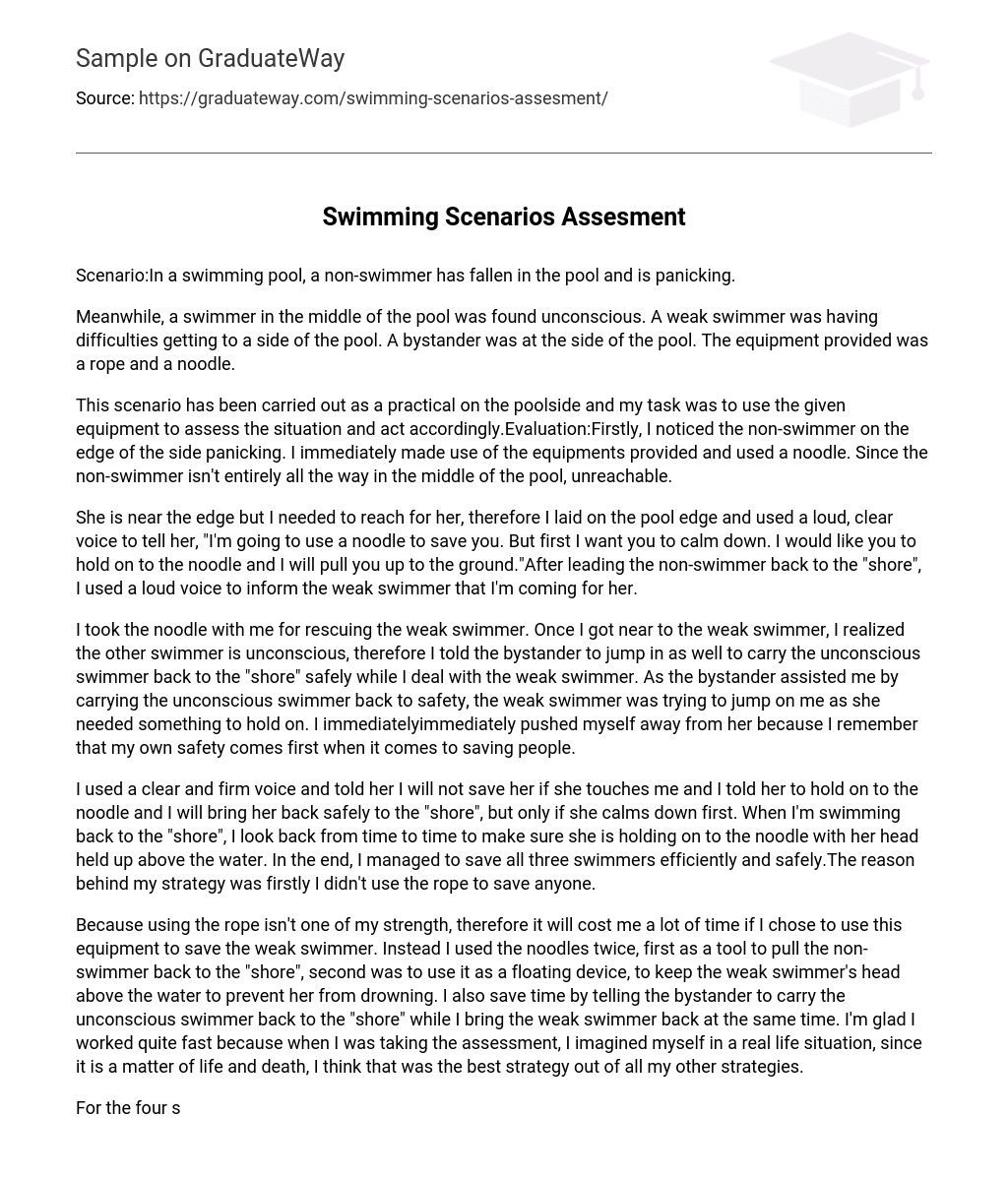Scenario:In a swimming pool, a non-swimmer has fallen in the pool and is panicking.
Meanwhile, a swimmer in the middle of the pool was found unconscious. A weak swimmer was having difficulties getting to a side of the pool. A bystander was at the side of the pool. The equipment provided was a rope and a noodle.
This scenario has been carried out as a practical on the poolside and my task was to use the given equipment to assess the situation and act accordingly.Evaluation:Firstly, I noticed the non-swimmer on the edge of the side panicking. I immediately made use of the equipments provided and used a noodle. Since the non-swimmer isn’t entirely all the way in the middle of the pool, unreachable.
She is near the edge but I needed to reach for her, therefore I laid on the pool edge and used a loud, clear voice to tell her, “I’m going to use a noodle to save you. But first I want you to calm down. I would like you to hold on to the noodle and I will pull you up to the ground.”After leading the non-swimmer back to the “shore”, I used a loud voice to inform the weak swimmer that I’m coming for her.
I took the noodle with me for rescuing the weak swimmer. Once I got near to the weak swimmer, I realized the other swimmer is unconscious, therefore I told the bystander to jump in as well to carry the unconscious swimmer back to the “shore” safely while I deal with the weak swimmer. As the bystander assisted me by carrying the unconscious swimmer back to safety, the weak swimmer was trying to jump on me as she needed something to hold on. I immediatelyimmediately pushed myself away from her because I remember that my own safety comes first when it comes to saving people.
I used a clear and firm voice and told her I will not save her if she touches me and I told her to hold on to the noodle and I will bring her back safely to the “shore”, but only if she calms down first. When I’m swimming back to the “shore”, I look back from time to time to make sure she is holding on to the noodle with her head held up above the water. In the end, I managed to save all three swimmers efficiently and safely.The reason behind my strategy was firstly I didn’t use the rope to save anyone.
Because using the rope isn’t one of my strength, therefore it will cost me a lot of time if I chose to use this equipment to save the weak swimmer. Instead I used the noodles twice, first as a tool to pull the non-swimmer back to the “shore”, second was to use it as a floating device, to keep the weak swimmer’s head above the water to prevent her from drowning. I also save time by telling the bystander to carry the unconscious swimmer back to the “shore” while I bring the weak swimmer back at the same time. I’m glad I worked quite fast because when I was taking the assessment, I imagined myself in a real life situation, since it is a matter of life and death, I think that was the best strategy out of all my other strategies.
For the four steps (the four A’s), I have performed the first three steps as quickly as possible.1. Awareness – I first recognized an emergency need to save the casualties in the pool because they were yelling for help and struggled in the water.2.
Assessment – I immediately assessed the environment, making sure the swimming pool is safe and made judgments on applying all I have learnt about life-saving.3. Action – I developed a plan as fast as I could to rescue the casualties and tried my best to rescue them effectively and efficiently.4, and After care – I was not able to do After care, this was due to lack of time.
If I had more time, I would learn about After care so I would be able to apply it to the task.If I were to do this rescue over again, I would observe the environment first and give clear instructions to the bystander before jumping into the water, because it will a waste of my energy to scream all the way to the bystander. Other than that, I think I will follow what I did this time as it was quite an efficient rescue.





